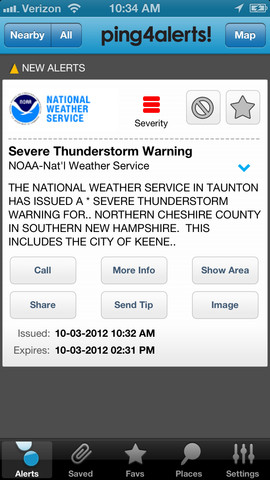 Smartphone-based public safety company Ping4 has raised $3.8 million to develop a next generation emergency alert system and market it worldwide. With more than a million from the founders of the company and $1.8 million raised between January and March last year, the new round brings the company up to $7 million in funding, Ping4 CEO Jim Bender told MobiHealthNews. The $3.8 million raise is made up of individual angel investors, and between two-thirds and three-quarters of the investors were returning from previous rounds, Bender said.
Smartphone-based public safety company Ping4 has raised $3.8 million to develop a next generation emergency alert system and market it worldwide. With more than a million from the founders of the company and $1.8 million raised between January and March last year, the new round brings the company up to $7 million in funding, Ping4 CEO Jim Bender told MobiHealthNews. The $3.8 million raise is made up of individual angel investors, and between two-thirds and three-quarters of the investors were returning from previous rounds, Bender said.
Ping4 creates an app-based alert system called Ping4alerts! for such diverse cases as nuclear reactor breakdowns, Amber Alerts for missing children, and disaster relief. The company sells its system to emergency services, who then reach the public by the means of a free app on their smartphones. They're planning to use the money to add additional features to their product, file for more patents, and develop a worldwide marketing team to sell their service outside the United States.
Ping4alerts! has a number of advantages over a traditional emergency alert system. For one thing, the alerts can be targeted hyper-locally, not just to residents of an area, but to visitors as well. This allows people to only be bothered by alerts relative to them, and allows the alerts to be tailored in cases where people in different areas need to take different precautions. Additionally, the system can send rich data, including pictures and videos, which can be especially useful in the case of a missing child, for instance, since app users can get pictures of the child and even snippets of security footage.
Finally, the app allows for two-way anonymous messaging. Users don't have to give up any information about themselves other than their location in order to get updates, and the system allows them to respond to alerts with anonymous tips in applicable cases.
Ping4 is years ahead the US government. In mid-2011 FCC chairman Julius Genachowski announced a plan to overhaul the existing 911 service to bring not only texting, but photo, video, and data support to what he called the Next Generation 911 service within five to ten years. Last year he announced plans to accelerate the rollout of the texting component.
For Ping4, one potential drawback is that it can only alert smartphone owners. But Bender argues that smartphone adoption is climbing quickly, especially in developing countries.
"It is what it is, but the numbers of smartphones are absolutely staggering, and so is the trend line," he said. "TVs were invented in the 1940s and in those 70-plus years we're just now getting to 2 billion screens. The personal computer was invented in 1980, now there are 1 billion units. Smartphones already dwarf both TVs and PCs, and the rate of adoption in 3rd world countries is very fast."
The free app currently runs on Apple and Android devices. The company has plans to develop for Microsoft eventually, said Bender, and will be watching BlackBerry to determine whether to invest development resources in the platform.
Health applications are among the uses the company potentially provides for, giving information about outbreaks and the location of medical services in cases of natural disaster. As the company moves toward global penetration -- and considers donating their system to the World Health Organization -- one area where the service could be immensely helpful is cholera outbreaks, Bender said.
"In the case of cholera, being able to tell mothers or caregivers that massive hydration can make a difference at the very start of an outbreak is something we can do through the smartphone without knowing anything about the people receiving those alerts," he said.

















